NVIDIA GeForce GTX 760 Review: The New Enthusiast Kepler
by Ryan Smith on June 25, 2013 9:00 AM ESTOverclocking GTX 760
Like the GTX 770 last month, the GTX 760 is clocked relatively high. Its 980MHz base clock is 65MHz higher than either the GTX 670 or GTX 660 Ti. As a result some of the overclocking headroom that we would expect has been eaten into by the overclock. Yet on the other hand the higher voltage for the highest boost bin – 1.2v versus 1.175v – gives us some additional overclocking headroom as long as our cooling can keep up.
At the same time the GTX 760 gets a slightly larger TDP adjustment window than most other GK104 parts. Here we can push the TDP up by up to 15%, from 170W to 195W. This is actually more than the GTX 770, so in TDP limited scenarios we should have a slightly easier time hitting the higher boost bins.
| GeForce GTX 760 Overclocking | ||||
| Stock | Overclocked | |||
| Core Clock | 980MHz | 1130MHz | ||
| Boost Clock | 1033MHz | 1183MHz | ||
| Max Boost Clock | 1149MHz | 1306MHz | ||
| Memory Clock | 6GHz | 6.5GHz | ||
| Max Voltage | 1.2 | 1.212v | ||
In practice GTX 760 ended up exceeding our expectations. In fact it even ended up exceeding GTX 770 with regard to the size of the overclock and the highest boost bin we reached. Altogether we were able to increase the core clock by 150MHz on our GTX 760 sample, going from a base clock of 980MHz to 1130MHz. At the same time our max boost clock went from 1149MHz to 1306MHz, making this the first Kepler we’ve seen to surpass 1300MHz. The end result is that core overclocking ends up being more potent than we were expecting.
Meanwhile the memory overclock is fairly standard for a GK104 part. It’s something of a roll of the dice, and in this case we were able to hit 6.5GHz before memory performance started regressing. Thus we’re altogether looking at a 15% core overclock coupled with a milder 8% memory overclock.
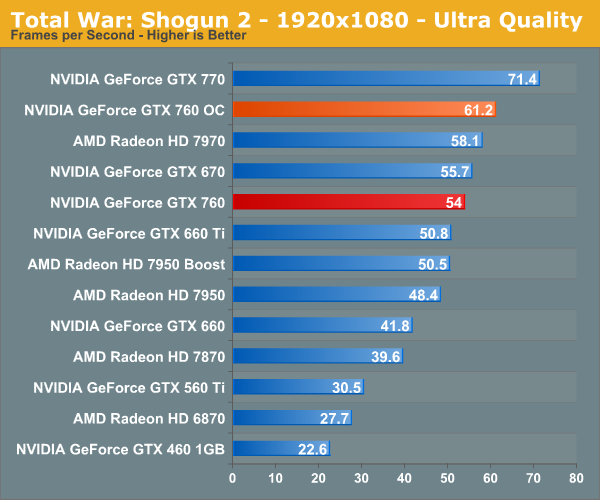
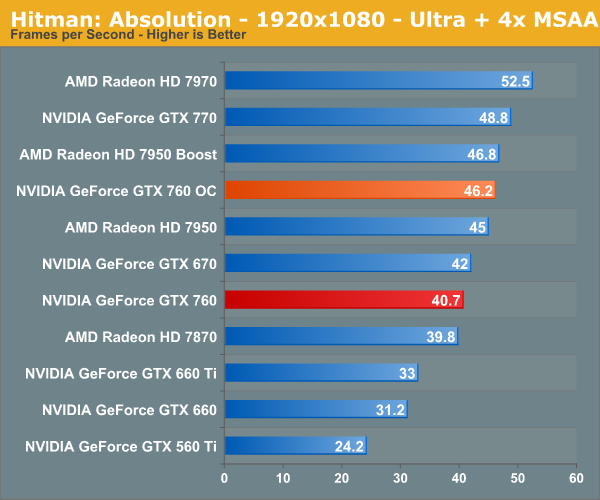
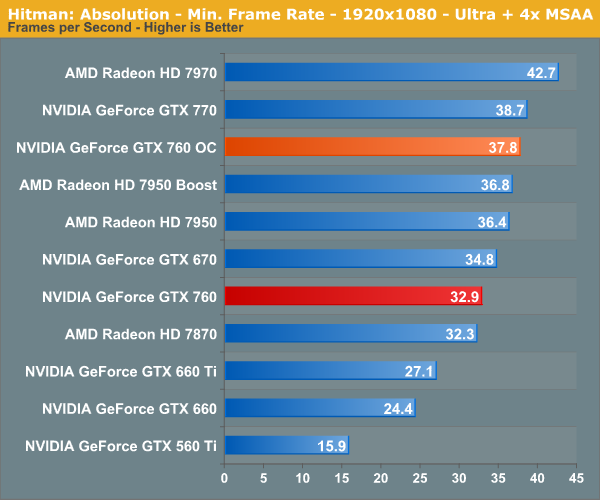
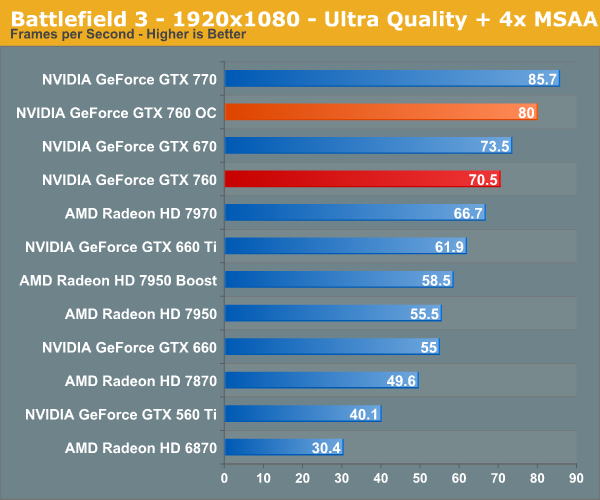
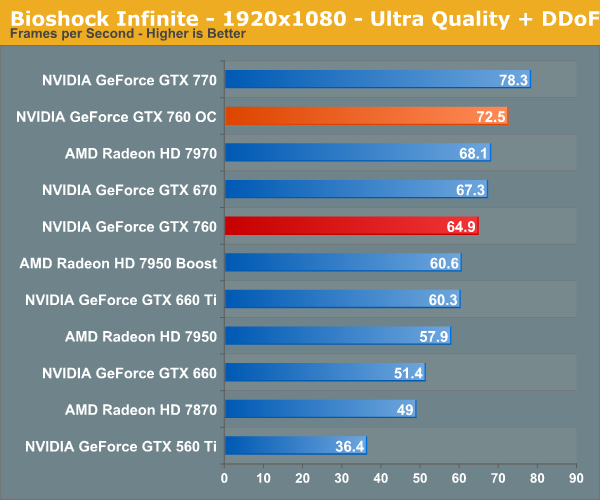
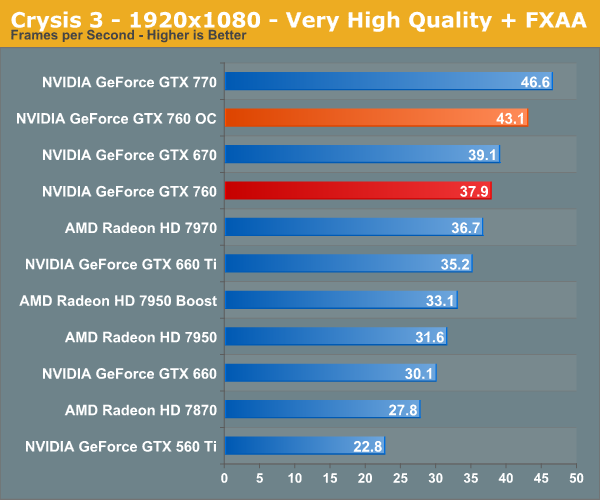
Given GTX 760’s base shader/texture performance deficit due to only having 6 SMXes, overclocking proves to be very effective on our final results. The performance gains in all 5 of our games were on the order of 12% to 14%, just a bit less than the core overclock itself. With the wide gap between the GTX 770 and GTX 760 in terms of specs this generally isn’t enough to completely catch up to NVIDIA’s top-tier GK104 card, but it can erase a large portion of the gap.
The end result of this overclock won’t dramatically change the GTX 760’s performance profile, but it should help to push it over 60fps in those situations where performance at 1080p at ultra quality settings was marginal. Or from a fixed performance standpoint, we’re approaching Radeon HD 7970 performance with this overclock.
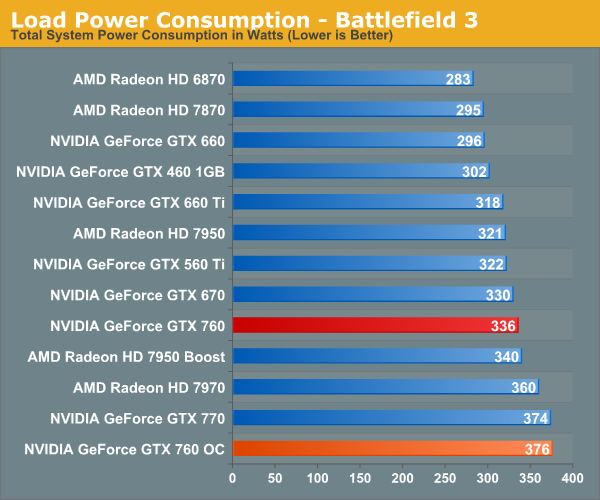
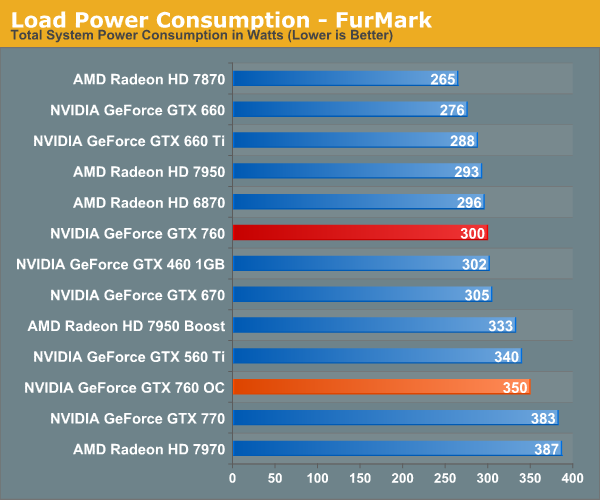
Moving on to power consumption, increasing our TDP has the expected hit. GTX 760 of course has a larger adjustment window than GTX 770, so the increase in power consumption ends up being noticeably larger. Overclocking in this manner pushes the GTX 760 off of the power/performance efficiency curve to some degree, so the GTX 760 loses its edge in that respect.
The end result is that power consumption at the wall jumps by 40W under BF3, and 50W under FurMark. This is tied with and better than the stock GTX 770 respectively, though as we’ve already seen it doesn’t match the GTX 770’s rendering performance. Furthermore as we’ll see, cooling is going to play a big factor here, with the reference GTX 760 cooler not always being the best choice for overclocking.
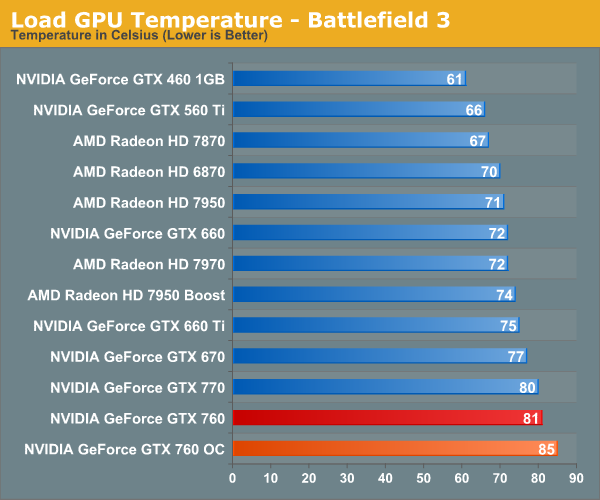
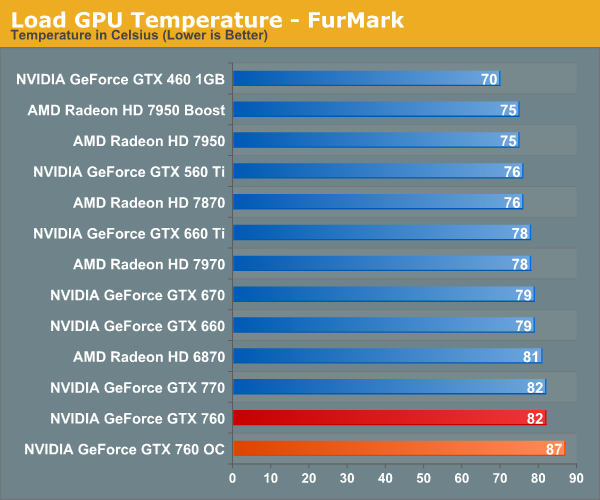
With the temperature limit raised to 95C, the reference GTX 760 cooler reaches equilibrium at 85C under BF3 and 87C under FurMark. These temperatures are still easily within spec for GK104, but they’re definitely starting to crawl up here. Meanwhile, though it’s not directly measurable the impact of leakage is certainly making itself felt here. If we had cooler temperatures power consumption would at least be marginally lower.
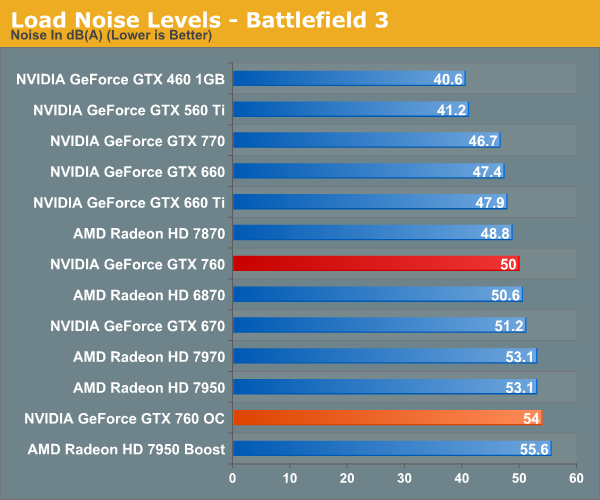
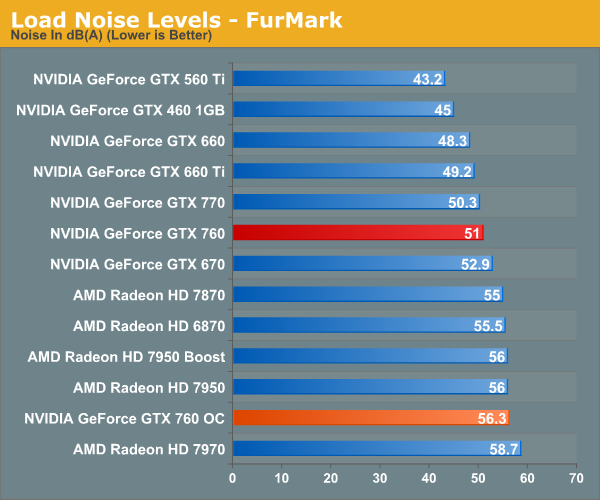
Finally we noise we can see that those new equilibriums also come at new, much higher noise levels. The reference cooler can keep up with the higher heat load created by overclocking, but it’s having to work hard to do so. These noise levels aren’t terrible – in fact they’re about even with the reference 7950 – but they do represent a real cost in terms of noise. Consequently, unlike NVIDIA’s Titan cooler that comes with the reference Titan, GTX 780, and GTX 770, when it comes to GTX 760 there’s very clearly room for improvement with custom coolers.










110 Comments
View All Comments
Spunjji - Tuesday, June 25, 2013 - link
Why would a faster card need to be cheaper? Shoo, shoo! Back under your bridge.UltraTech79 - Tuesday, July 2, 2013 - link
???vailr - Tuesday, June 25, 2013 - link
Will there be a "Small Form Factor" version, similar to:http://www.newegg.com/Product/Product.aspx?Item=N8...
chizow - Tuesday, June 25, 2013 - link
Sad day in the GPU industry when a part that's ~75% of the *SECOND* tier ASIC and sells for $250 can be considered "Enthusiast".It looks like Nvidia's marketing push to carve out ultra and uber enthusiast markets has worked, on the media anyways. Parts in this range used to be referred to as mainstream/midrange performance or gamer cards in the past, never once referred to as "Enthusiast".
Honestly if this $250 part is "Enthusiast" what are the $400 770, the $650 780, the $1000 Titan??? I guess we need to cough up $250 more for each Uber we place in front of Enthusiast; maybe at some point we just find new words and categories when one has been devalued and depreciated to the point it no longer holds any meaning.
Aside from the rant, the part's price and performance looks good. It's pretty clear at this point Kepler benefits more right now from the ROPs and bandwidth than SP and TMU. May change with future shader intensive titles, but the 760 pretty much confirms the 660Ti (and virtually any 30%+ bandwidth-neutered parts) was a big mistake.
thesavvymage - Tuesday, June 25, 2013 - link
who cares what ASIC it comes from, its irrelevant. Its a $250 gpu that performs as well or better than more expensive cards. Thats not mainstream, its enthusiast. Everything above it is enthusiast. The absolutely biggest amount of gpu sales come from those south of $200, so thats what most people consider mainstream.chizow - Wednesday, June 26, 2013 - link
People who don't enjoy getting less for the same price care what ASIC it comes from. I guess you don't mind getting smaller and smaller burgers, or less and less ounces in the food you buy at the grocery each year?There is nothing enthusiast about this product, it's mainstream performance in the same price and market bracket that litters all of Nvidia's previous marketing slides in this $200-$300 range. Was the 8800GT an enthusiast card? No. Was the 560Ti an enthusiast card? No. Yet they both satisfy the criteria you set forth.
teiglin - Tuesday, June 25, 2013 - link
I was just thinking about this after reading the review over at Tom's (they refer to the 760 as mainstream). It's an interesting sociological exercise, how different people view the term enthusiast. Given the massive stratification at the high end--I mean, Titan, ffs--what is the cutoff for being an "enthusiast" card? Why even bother with hyperbolic modifiers when nobody who spends even $400 on a GPU would do so without knowing the difference between a 770, a 780, and a Titan, not to mention the 7970 [GHz edition], 7950 [Boost], etc.?Personally, I'm inclined to agree with Ryan here. This is still a heckuva lot more graphics horsepower than, say, certain yet-to-be-released consoles, which I would argue define a "mainstream" baseline. Though if you're just commenting on how much the lowest common denominator in graphics performance has fallen, then that may be a sad day for the GPU industry, but it's a good day for consumers, who are able to get way more GPU for much less money than a couple years ago.
chizow - Wednesday, June 26, 2013 - link
Sorry but getting "way more GPU for much less money than a couple years ago" is just progress and should be expected.The context for how different people view the term enthusiast should be consistent, based on historical price and performance categories as well as physical and marketing segmentation factors. All of which indicate this is NOT an enthusiast part. Nvidia has clearly defined this in the past, and the enthusiast market did not start until $350+.
Some may say, "who cares", I guess people who actually shop in this $350+ market care, because calling a $250 part sets a terrible precedent, same as selling a tier-2 midrange ASIC like GK104 at $500 sets a terrible precedent. Why? Because if Nvidia is selling their 2nd fastest ASIC at "Enthusiast" price ranges starting at $250 all the way to $500, that gives them license to sell their actual Enthusiast parts at much more than $500.
Is it any surprise that we now have $650 GTX 780 and $1000 GTX Titan and GTX 690? Of course not. Why? Because people are doing cartwheels in the streets over the privilege of buying a stripped down, overclocked 2nd-tier ASIC for $250, because it's the new enthusiast part!
UltraTech79 - Tuesday, July 2, 2013 - link
I put the $1000 Tital as 'Rich retard soon parts with his money.' Also, shut the fuck up elitest dumbfuck. Anyone willing to spend $200+ on a GPU is an enthusiast and is looking for more than just enough.chizow - Friday, July 5, 2013 - link
Yes just like the guy who rices up his Civic is now driving a "luxury sports car". Just another idiot that doesn't understand I'm actually advocating against elitest pricing and marketing brackets, move along if you don't understand the concepts and repercussions.